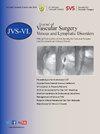西罗莫司治疗小儿头颈部淋巴畸形的真实世界研究。
IF 2.8
2区 医学
Q2 PERIPHERAL VASCULAR DISEASE
Journal of vascular surgery. Venous and lymphatic disorders
Pub Date : 2025-03-18
DOI:10.1016/j.jvsv.2025.102230
引用次数: 0
摘要
目的:西罗莫司在治疗淋巴畸形(LMs)方面显示出良好的前景;然而,之前的研究都是单臂临床试验。先前的研究报道,一些LMs病变可以自发缩小,这是评估治疗结果的潜在混淆因素。本研究旨在通过对比对照组的疗效,客观评价口服西罗莫司治疗头颈部LMs的有效性和安全性。方法:这项现实世界的研究纳入了北京儿童医院2020年至2023年的57名LMs患儿。患者分为非干预组和口服西罗莫司组。主要转归是MRI上病变体积的改变,次要转归是临床症状的改善。安全性评估基于不良反应(定期实验室检查和患者随访)和口服西罗莫司组的西罗莫司血药浓度。结果:非干预组21例患儿(M/F = 14/7),中位年龄33个月(四分位数间距[IQR], 9-53.5);口服西罗莫司组36例患儿(M/F = 15/21),中位年龄为24个月(IQR, 7.5-51.25)。非干预组容积缩小比中位数为0.08 (IQR, 0.30-0.40),有效8例(38.1%)。口服西罗莫司组中位体积缩小比为0.67 (IQR, 0.40 ~ 0.92),有效33例(91.7%)。无干预组9例(42.9%)患儿临床症状改善,口服西罗莫司组35例(97.2%)患儿临床症状改善。有效率和体积变化差异有统计学意义(P < 0.001)。口服西罗莫司组最常见的不良反应是心肌酶水平升高(n = 23, 63.9%),其次是口腔溃疡(n = 16, 44.4%)。口服西罗莫司组给药期间西罗莫司整体血药浓度偏低,其中10例(27.8%)患儿平均血药浓度< 5 ng/ml。结论:西罗莫司可显著减少大部分LMs患者的病变体积,改善临床症状,尤其是伴有大囊性成分的LMs患者。保守观察仅对一些患者有帮助,体积变化相对较小。本文章由计算机程序翻译,如有差异,请以英文原文为准。
A real-world study of sirolimus in the treatment of pediatric head and neck lymphatic malformations
Objective
Sirolimus has shown promise in treating lymphatic malformations (LMs); however, previous studies were all single-arm clinical trials. Prior studies have reported that some LMs lesions can spontaneously reduce, which poses a potential confounding factor in evaluating therapeutic outcomes. Our study aimed to assess the effectiveness and safety of oral sirolimus objectively for LMs in the head and neck by comparing the outcomes in a control group.
Methods
This real-world study involved 57 children with LMs from 2020 to 2023 at Beijing Children's Hospital. The patients were divided into nonintervention and oral sirolimus groups. The primary outcome was lesion volume change on magnetic resonance imaging, and the secondary outcome was improvement in clinical symptoms. Safety was assessed based on adverse reactions (regular laboratory tests and patient follow-ups) and sirolimus blood concentrations in the oral sirolimus group.
Results
Twenty-one children were enrolled in the nonintervention group (14 male and 7 female), with a median age of 33 months (interquartile range [IQR], 9-53.5 months); 36 children were enrolled in the oral sirolimus group (15 male and 21 female), with a median age of 24 months (IQR, 7.5-51.25 months). The median volume reduction ratio in the nonintervention group was 0.08 (IQR, 0.30-0.40), and eight cases (38.1%) had an effective response. The median volume reduction ratio in the oral sirolimus group was 0.67 (IQR, 0.40-0.92), and 33 cases (91.7%) had an effective response. Clinical symptoms improved in 9 children (42.9%) in the nonintervention group and 35 (97.2%) in the oral sirolimus group. The effective rate and volume changes differed statistically significantly (P < .001). The most common adverse reaction in the oral sirolimus group was an increase in myocardial enzyme levels (n = 23 [63.9%]), followed by oral ulcers (n = 16 [44.4%]). The overall blood concentration of sirolimus was low during the drug administration in the oral sirolimus group, among which 10 children (27.8%) had a mean blood concentration of <5 ng/mL.
Conclusions
Sirolimus significantly decreased lesion volume and improved clinical symptoms in most patients with LMs, especially those with macrocystic components. Conservative observations were only helpful in some patients, with relatively modest volume changes.
求助全文
通过发布文献求助,成功后即可免费获取论文全文。
去求助
来源期刊

Journal of vascular surgery. Venous and lymphatic disorders
SURGERYPERIPHERAL VASCULAR DISEASE&n-PERIPHERAL VASCULAR DISEASE
CiteScore
6.30
自引率
18.80%
发文量
328
审稿时长
71 days
期刊介绍:
Journal of Vascular Surgery: Venous and Lymphatic Disorders is one of a series of specialist journals launched by the Journal of Vascular Surgery. It aims to be the premier international Journal of medical, endovascular and surgical management of venous and lymphatic disorders. It publishes high quality clinical, research, case reports, techniques, and practice manuscripts related to all aspects of venous and lymphatic disorders, including malformations and wound care, with an emphasis on the practicing clinician. The journal seeks to provide novel and timely information to vascular surgeons, interventionalists, phlebologists, wound care specialists, and allied health professionals who treat patients presenting with vascular and lymphatic disorders. As the official publication of The Society for Vascular Surgery and the American Venous Forum, the Journal will publish, after peer review, selected papers presented at the annual meeting of these organizations and affiliated vascular societies, as well as original articles from members and non-members.
 求助内容:
求助内容: 应助结果提醒方式:
应助结果提醒方式:


